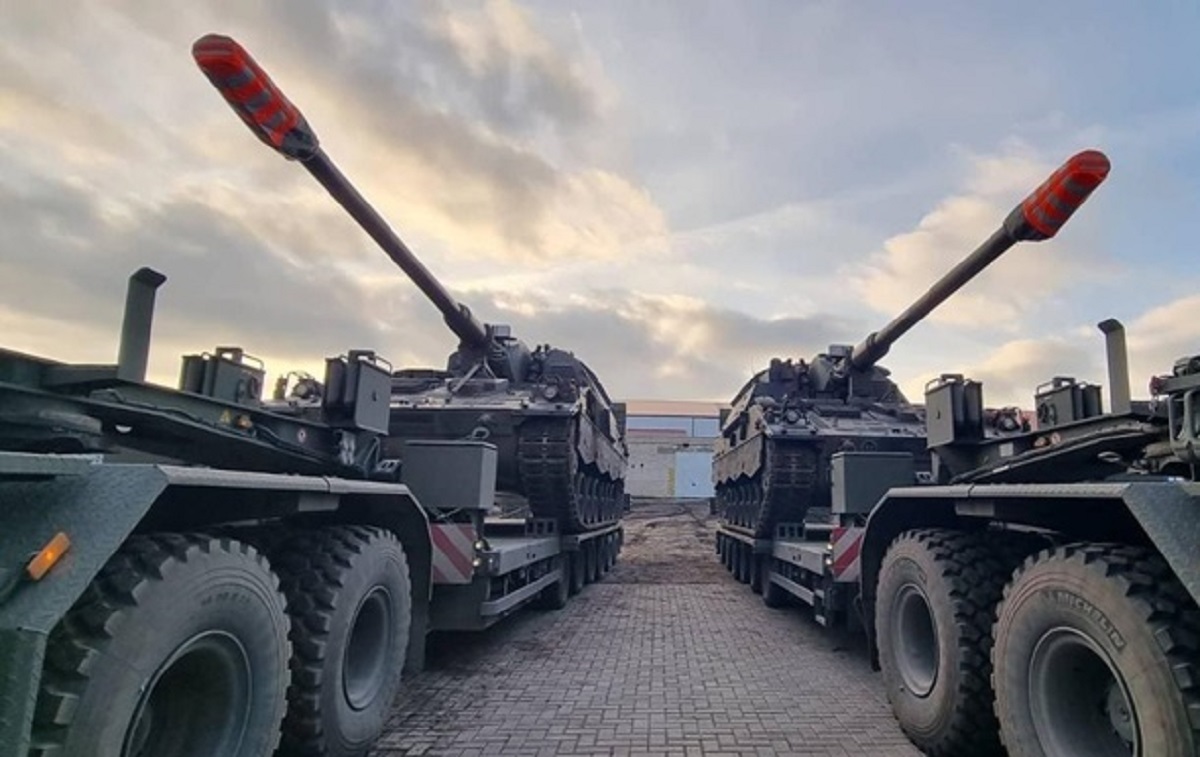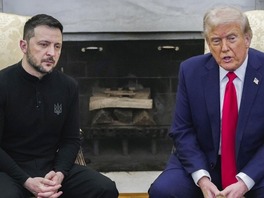President Biden is enhancing immigration policy to quell Republican criticism and bolster support for Ukraine. According to The Wall Street Journal, the White House compromise, now under Senate consideration, entails restricting asylum applications at the US southern border. This approach encounters hurdles as House Republicans present more stringent demands.This development raises concerns about the Ukrainian military-industrial complex's capacity to fulfill Defense Forces needs amidst potential delays in the US agreement. Explore alternative arms sources from Britain and EU countries in the Apostrophe article.
With a sense of restrained optimism
Just ahead of The Wall Street Journal release, Joe Biden urged lawmakers in a meeting to lift the block on additional aid to Ukraine swiftly.
President Biden, as per the White House, emphasized the urgent need for aid to Ukraine, specifying air defense systems and artillery. He warned that Congressional delays jeopardize US national security, NATO stability, and global freedom. Additionally, he addressed the Republican Party's concern for securing the southern US border.
Mitch McConnell, the Senate Republican leader, hinted at bipartisan talks on southern border security and Ukraine aid next week. Meanwhile, Senate Democrat representative Chuck Schumer expressed newfound optimism about reaching an agreement.
This positive outlook carries crucial significance for Ukraine, as the United States presently serves as its primary provider of military and technical support.
‘The crucial point is that the bulk of military aid comes from the United States, averaging $24-27 billion annually since February 2022. European contributions suffice for defense but fall short for offensive operations and liberating occupied territories without U.S. assistance. For instance, while France providing 40 long-range missiles is appreciated, a more substantial 400-missile delivery would enable larger-scale operations,’ military expert Ivan Stupak tells Apostrophe.
Berlin and Paris Set to Begin
A day before the meeting with congressmen, Joe Biden had a phone call with German Chancellor Olaf Scholz. Following the conversation, the German leader announced Berlin's commitment to supplying Kyiv with military equipment valued at 7 billion euros this year.
‘President Biden and I agree: we want to continue to provide Ukraine with financial, humanitarian, and military support. Today, I spoke to @POTUS on the phone. Germany is providing more than seven billion euros in military goods in 2024,’ Scholz tweeted in X.
The White House confirmed the conversation, emphasizing that the leaders affirmed their nations' ongoing steadfast support for Ukraine.
The German parliament opposition party, the Christian Democratic Union, which former Chancellor Angela Merkel was part of, proposed discussing the transfer of Taurus long-range missiles to Ukraine in the Bundestag on the same day. However, the vote failed due to procedural reasons.
German lawmakers will revisit this matter. According to Verkhovna Rada MP Yehor Chernyov, the bill was dismissed not on its substance but due to procedural lapses and attempts to exploit the vote for narrow-party publicity. He anticipates the next vote will likely occur before February 22.
France plans to supply Ukraine with a monthly allocation of up to 50 AASM Hammer aerial bombs until the conclusion of 2024, Le Figaro reports.
France's Defense Minister, Sebastien Lecornu, specified that from January this year until the conclusion of 2024, France will consistently deliver the mentioned bombs to Ukraine.
The AASM Hammer, featuring a tail bay, solid propellant jet engine, and nose guidance system for extended range, includes an air burst function. Its warhead can range from 125 to 250, 500 and 1000 kg. Ukraine had previously received JDAM-type bombs, similar in characteristics to the AASM.
The minister additionally revealed a surge in artillery ammunition supply. From February 2022 to end of 2023, France delivered 2,000 shells monthly, the count has now been upped to 3,000 since January this year.
France also intends to provide Ukraine with 40 long-range SCALP missiles, analogues of Storm Shadow missiles. Depending on the modification, these missiles can target distances of 250, 500, and 700 km. However, the missiles supplied to Ukraine will have a range of up to 250 km.
Just days prior to this disclosure, French President Emmanuel Macron revealed plans for delivering approximately 40 long-range Scalp missiles and ‘several hundred bombs’ to Ukraine. He also mentioned a forthcoming visit to Kyiv to finalize a bilateral security guarantees agreement. Presumably, Le Figaro initially reported on these deliveries, with Minister Lecornu subsequently confirming the pre-existing decision.
‘I will go myself to Ukraine in February and finalise these texts’, Reuters quoted Macron.
Macron emphasizes the EU's responsibility to ensure Kyiv's defense against Kremlin aggression. He asserts that allowing Vladimir Putin to prevail in Ukraine would jeopardize the security of the entire European continent.
The tip of the iceberg?
Yet, the pertinent question persists: why disclose precise figures on arms deliveries, essentially briefing the Kremlin?
‘We lack the authority to dictate the French president's statements. He likely has strategic reasons for his disclosure, possibly revealing only a tip of the iceberg. Nonetheless, the provision of 40 long-range Scalp missiles offers a potent means to target significant Russian assets in occupied territories. Optimism surrounds US assistance, with the White House emphasizing that a substantial portion of allocated funds benefits the American military-industrial complex, producing weapons for Pentagon warehouses, rather than direct transfers to Kyiv’, Oleksandr Kovalenko, military and political columnist of the Information Resistance group, tells Apostrophe.
Despite political tensions in the USA, the expert predicts Ukraine will likely face no issues in missile supply for Patriot air defense systems and HIMARS systems this year. Stocks are available in European Union warehouses, and South Korea and Japan also possess similar missiles.
It is crucial to acknowledge Ukraine's collaborative efforts in adapting Western missiles to Soviet launchers, a successful initiative. According to Ukraine's Minister of Strategic Industries, Oleksandr Kamyshyn, the Defense Forces utilized the inaugural hybrid air defense system, dubbed FrankenSAM, to successfully intercept the Shahed-136.
FrankenSAM is a hybrid system merging Western missiles with Soviet air defense, typically utilizing depleted "Buk" systems. Ukrainian and American engineers revamped Soviet SAMs and radars for American missiles like RIM-7 and AIM-9. These hybrids outperform their ‘parent’ originals, primarily by creating confusion for the enemy.
‘When Russians target Ukraine with missiles and drones, attempting to assess our radar capabilities, they encounter the Soviet "Buk" system, understanding its missile range. However, our counteraction involves missiles reaching Russian air targets significantly farther away, with an expanded interception range. This complicates Russian orientation in battle and intensifies challenges in adapting to our anti-aircraft defenses, making loopholes harder to find,’ military expert, reserve colonel of the Armed Forces of Ukraine Roman Svitan explains.
In a similar vein, we tailored the deployment of Patriot missiles and corresponding kits for Ukrainian former-Soviet radar systems, bolstering the precision in striking Russian air targets.
‘The Russians lack a specific countermeasure, leaving them cautious of any Ukrainian radar, uncertain about the potential missile threat. Consequently, it becomes more challenging for their aircraft to approach the battlefront,’ Svitan said.
Europe Gears Up
The conflict in Ukraine has heightened defense readiness in Poland, Lithuania, Latvia, and Estonia. The rationale is clear – these nations could be potential Kremlin targets if the Western alliance commits a strategic misstep by permitting Ukraine's defeat.
Europeans are not just fortifying their defenses; they're leveraging military equipment for commercial gains. Recently, Bulgarian Defense Minister Todor Tagarev revealed that a substantial portion of Bulgarian weapons finds its way to Ukraine.
The primary focus lies on manufacturing ammunition, small arms, and light weapons, a sector with roots from the USSR era that remains highly active in Bulgaria. Tagarev highlights that a significant portion of these products is consistently sent to Ukraine, at times through intermediaries, sustaining continuous operations.
He also discussed intentions to broaden production, encompassing NATO-standard ammunition. In this regard, Bulgarian firms sought investments from the European Commission through the ASAP program to boost ammunition production in the EU. Bulgaria expresses interest in joining the F-16 coalition, offering political, diplomatic, and humanitarian backing to Ukraine. Furthermore, Bulgaria aligns with the G7 declaration backing Ukraine and has extended the aid program for Ukrainian refugees until April 2024.
Simultaneously, Minister Tagarev acknowledged that Bulgaria hasn't yet transferred 100 armored personnel carriers from police stockpiles to Kyiv, citing logistical considerations. He clarified that efforts in this direction are ongoing.
Taking Matters Into Our Own Hands
‘Strategically, Ukraine aims for a degree of self-sufficiency in ammunition and weapons production. Full autonomy, typical in authoritarian regimes, would be challenging for us, given our adherence to democracy. Democratic states navigate compromises between state-owned and private military-industrial complex entities. Entering a closed production cycle for specific ammunition is crucial to reduce reliance on foreign political circumstances,’ Oleksiy Melnyk, co-director of foreign policy and international security programs at the Razumkov Center, tells Apostrophe.
In the past year, Ukraine launched the International Alliance of Defense Industries, open to global manufacturers of weapons and military equipment. President Zelensky shared this initiative at the inaugural International Forum of Defense Industries in Kyiv last September, attracting participants from over 30 countries and 252 defense companies.
Zelensky underscores Ukraine's production of 155 mm caliber artillery and NATO-standard projectiles, along with indigenous anti-tank systems. The Alliance's objective is to fortify international law and safeguard against aggression from any country.
Post-forum, the Alliance boasts 38 companies from 19 nations. Ukraine inked 20 agreements, spanning drone production, armored vehicle repair and creation, and ammunition. The collaborations encompass joint production, technology exchange, and component supply. Notably, Ukraine secured a joint weapons production deal with the USA and intends to manufacture Swedish CV-90 BMPs and ASCOD infantry fighting vehicles adhering to NATO standards. Germany also granted Rheinmetall permission to establish a joint defense enterprise with Ukraine.
‘Our primary focus lies in missile, UAV, and ammunition production, critical expenditures in the 21st-century technological warfare landscape. With the USA eyeing joint weapons production, emphasis should be on missiles and drones. Experts highlight our capacity to produce hundreds of Neptune-type missiles, demonstrated through the success of the FrankenSAM project. This underscores the resilience of our missile enterprises and their ability to innovate in weapon production,’ military expert, head of the Army, Conversion and Disarmament Research Center Valentyn Badrak tells Apostrophe.
However, kickstarting production and fulfilling specific military requests for the Defense Forces of Ukraine is time-consuming, and the urgency of their needs is undeniable. Much of the information about Ukraine's current military-industrial complex operations remains classified as a military and technical secret. The events of last year, where naval drones constrained the Russian fleet in the Black Sea's southeastern part and modernized Neptune and S-200 systems reached deep into Russian territory with some undisclosed weaponry, highlight Ukraine's active and innovative defense strategies.
Experts note that the Ukrainian military industry, coupled with European support, should suffice to deter Russian invaders this year. However, in the face of potential mass mobilization or significant advances by the Ukrainian Armed Forces General Staff, Washington's assistance may become indispensable.






